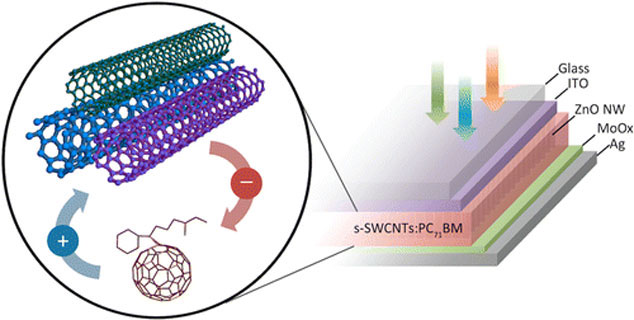
Carbon Nanotubes Get Better as Solar Cells
EVANSTON, Ill., Sept. 4, 2014 — A new type of carbon nanotube has taken a “big jump” beyond its predecessors in solar cell applications.
Single-walled carbon nanotubes (SWCNT), developed by a team from Northwestern University’s McCormick School of Engineering, have increased flexibility and more than twice the efficiency of previously created CNTs.
“The field had been hovering around 1 percent efficiency for about a decade; it had really plateaued,” said Dr. Mark Hersam, professor of materials science and engineering. “But we’ve been able to increase it to over 3 percent.”
A mixture of polychiral semiconducting nanotubes maximized the amount of photocurrent produced by absorbing a broader range of solar-spectrum wavelengths, meaning the SWCNTs absorb more sunlight. The solar cells were found to significantly absorb near-infrared wavelengths, a range that the researchers said had previously been inaccessible to many leading thin-film technologies.

Single-walled carbon nanotubes have demonstrated more than twice the efficiency of earlier carbon nanotubes in solar cell applications. Courtesy of ACS Publications.
The researchers hope to create polychiral carbon nanotube solar cells that have multiple layers. Each layer would be optimized for a particular portion of the solar spectrum. Other materials could be incorporated, too, such as organic or inorganic semiconductors that would complement the nanotubes.
“What we’d like to do is absorb every photon from the sun and convert it into electricity,” Hersam said. “In other words, we’d like to have a solar cell that has an absorption spectrum perfectly matching solar light.”
The SWCNTs possess “highly desirable attributes for solution-processable thin-film photovoltaics (TFPVs), such as broadband absorption, high carrier mobility and environmental stability,” the researchers wrote in the study.
“If you look at our performance, there’s certainly a big jump,” Hersam said. “But there’s more work to be done. We still have to advance this technology by a factor of three to five.”
The research was published in Nano Letters (doi: 10.1021/nl5027452).
For more information, visit www.mccormick.northwestern.edu.
Published: September 2014